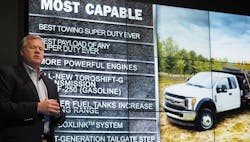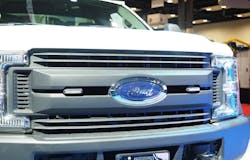Ford showcases ‘toughest, smartest, most capable’ Super Duty ever
INDIANAPOLIS. There was no mistaking the message: the all-new Ford Super Duty is the "toughest, smartest and most capable" ever built, and the automaker showed off the pickup line as well as the new Transit van series Tuesday evening, March 1.
It was at the NTEA Work Truck Show in Indianapolis. Ford gathered reporters for a press event showcasing the Super Duty's new features and the engineering and testing that went into them. The company says the all-new F-350, F-450 and F-550 chassis cab lineup is optimized to help commercial customers be more productive on the job — "from clearing snow-filled streets to rescuing stranded motorists to restoring power in a storm."
"We're the only OEM in the North American market that has a product in every class: 1-7," said John Ruppert, general manager of commercial vehicle sales and marketing at Ford.
"Commercial truck customers need tough, capable trucks that can haul heavy equipment to crush challenging jobs," said Craig Schmatz, chief engineer for Ford Super Duty. "The innovations our team has put into the next-generation Super Duty chassis cab are paying off by delivering capability that surpasses the competition."
The next-generation F-350, F-450 and F-550 Super Duty chassis cab lineup features:
• Best-in-class front gross axle weight rating of up to 7,500 lbs. — 250 lbs. more than the closest competitor — that supports carrying larger equipment like snowplows, taller utility buckets and cranes, larger ambulance bodies or other specialized vocational body upfits.
• Best-in-class gross combined vehicle weight rating of up to 40,000 lbs., including the truck and everything it can haul and tow. Ford reps pointed out that that is half the maximum gross combined weight rating of an 18-wheeler semi on most U.S. federal highways.
• 330 hp and 750 lbs.-ft. of torque from a second-generation Ford-designed, Ford-built 6.7L Power Stroke V-8 diesel, which the company notes are the best-ever ratings for Class 4 and Class 5 Super Duty chassis cab
All-new frame
Thanks to an all-new frame, the F-350, F-450 and F-550 F-Series chassis cab delivers more work capability.
The frame is the most rigid ever used in a Super Duty chassis cab. It features 95% high-strength steel with eight times more torsional rigidity than the previous frame, Ford says, thanks to welded crossmembers and fully boxed rails under the cab and forward. Open C-channel frame rails behind the cab are designed to enable easier body and vocational equipment upfits. All this helps deliver the 40,000-lb. max gross combined weight rating and 500-lb. increase in front gross axle weight rating, along with increased towing capacity over the previous Super Duty chassis cab.
Weight savings
Using advanced materials, Ford says it saved up to 350 lbs. in the all-new F-Series Super Duty and reinvested the savings into tougher, stronger components. For the first time, the Super Duty body uses high-strength, military-grade aluminum alloy throughout the cab, which improves dent and ding resistance while saving weight for significant increases in towing and payload capability, according to the company.
In addition to the heavier-duty fully boxed frame under the cab, Ford says many components "are more robust in the new Super Duty — including axles, suspension, driveline and towing hardware."
Powered by Ford
The 2017 Super Duty chassis cab with second-generation 6.7L Power Stroke V-8 diesel paired with a commercial-grade six-speed 6R140 automatic transmission adds 30 horsepower and 90 lbs.-ft. of torque for a maximum rating of 330 hp and 750 lbs.-ft. — the highest ever for Super Duty chassis cab.
Ruppert said Ford is the only heavy-duty truck manufacturer to design and build its own diesel engine and transmission combination, which ensures the powertrain works seamlessly with all chassis components and vehicle calibrations. The approach enables Ford engineers to optimize vehicle performance across the entire lineup, he said.
500,000-mi. B10 life
• The 6.7L Power Stroke V-8 diesel engine for the Ford F-650 and F-750 medium-duty truck line has a B10 design life of at least 500,000 mi., according to Ford, meaning 90% of the engines are expected to go farther than that without requiring a major service that involves removal of cylinder heads or dropping the oil pan to reach internal components.
• The Ford 6.7L diesel engine and Ford TorqShift HD six-speed automatic transmission are designed for medium-duty use with "great power, performance and fuel economy — backed by unsurpassed warranty and national network of Ford service centers."
"F-650 and F-750 customers help keep America moving," Ruppert said. "We're here to make sure they can with our all-new medium-duty trucks — whether that's trucking freight from Los Angeles to New York, or helping keep the lights on in your neighborhood."
The three diesel power levels available are 270 hp/675 lbs.-ft. of torque, 300 hp/700 lbs.-ft. of torque and 330 hp/725 lbs.-ft. of torque. Built at Ford's Ohio Assembly Plant near Cleveland with available straight frame and tractor configurations, the 2017 Ford F-650 and F-750 medium-duty trucks are now available for sale.
About the Author
Aaron Marsh
Aaron Marsh is a former senior editor of FleetOwner, who wrote for the publication from 2015 to 2019.


